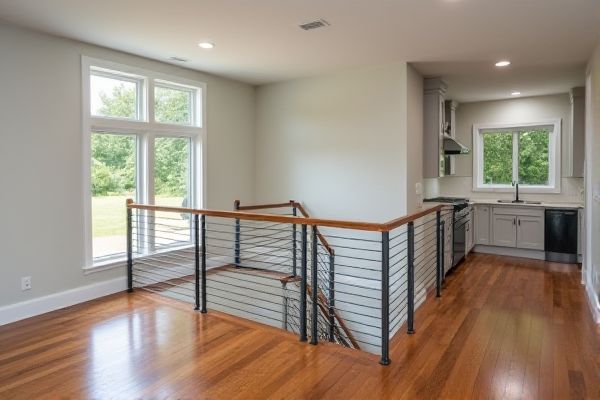
Cable railing offers a sleek, modern look with minimal visual obstruction, making it ideal for open spaces and waterfront views, while baluster railing provides a traditional, sturdy design with vertical posts that ensure enhanced safety and compliance with building codes. Explore the article to discover which railing style best suits your outdoor space and aesthetic preferences.
Table of Comparison
| Feature | Cable Railing | Baluster Railing |
|---|---|---|
| Material | Stainless steel cables with metal or wood posts | Wood, metal, or composite spindles/posts |
| Appearance | Modern, minimalistic, open view | Traditional, solid, decorative |
| Installation | Requires tensioning tools, professional recommended | Simple to install, DIY friendly |
| Maintenance | Low; occasional cable tightening and cleaning | Medium; depends on material, may need painting or sealing |
| Durability | High; weather-resistant stainless steel cables | Varies; wood prone to rot, metal may rust without treatment |
| Cost | Moderate to high due to hardware and installation | Low to moderate depending on material |
| Safety | Meets building codes with proper tensioning, gap size varies | Strong barriers, consistent spacing for safety |
| Best Use | Modern homes, maximizing views | Classic designs, decorative appeal |
Introduction: Cable Railing vs Baluster Railing
Cable railing offers a modern, minimalist aesthetic with horizontal stainless steel cables that provide unobstructed views and enhanced safety for decks and staircases. Baluster railing features vertical posts, typically made from wood, metal, or glass, offering a classic, sturdy design that complements traditional architecture and provides reliable support. Choosing between cable and baluster railings depends on desired style, visibility needs, and maintenance preferences for residential or commercial applications.
Overview of Cable Railing Systems
Cable railing systems offer a modern, sleek alternative to traditional baluster railings, featuring horizontal or vertical stainless steel cables tensioned between posts to provide an unobstructed view and enhanced durability. These systems prioritize safety without sacrificing aesthetics, making them ideal for decks, balconies, and staircases where visibility is key. Your choice between cable and baluster railings can significantly influence the overall design and maintenance requirements of your outdoor or indoor space.
Overview of Baluster Railing Systems
Baluster railing systems feature vertical posts, typically made of wood, metal, or composite materials, designed to provide strength and safety while supporting the handrail. These systems are widely favored for their traditional aesthetic, offering a classic look that complements various architectural styles and enhances your outdoor or indoor spaces. Baluster railings are versatile and customizable, available in numerous designs, spacings, and finishes to match specific safety codes and personal preferences.
Aesthetic Differences and Visual Appeal
Cable railing offers a sleek, modern aesthetic with its thin stainless steel wires creating an almost invisible barrier that enhances open views and complements contemporary architecture. Baluster railing features vertical posts that provide a classic, traditional look with more solid visual lines, often crafted from wood or metal to add texture and design variety. Your choice depends on whether you prefer the minimalist transparency of cable railing or the defined structure and timeless charm of balusters.
Installation Process Comparison
Cable railing installation involves tensioning stainless steel cables between posts, requiring precise alignment and specialized tools to ensure safety and durability. Baluster railing installation is typically more straightforward, involving fixed vertical balusters attached to the handrail and base rail, often compatible with standard carpentry tools. Your choice depends on the ease of installation and the aesthetic appeal, with cable railings demanding more technical skill compared to the relatively simple setup of balusters.
Durability and Maintenance Needs
Cable railing systems offer exceptional durability due to their stainless steel construction, which resists rust and corrosion, making them ideal for outdoor use in harsh weather conditions. Baluster railings, often made from wood, aluminum, or wrought iron, demand more frequent maintenance such as painting, staining, or rust treatment to maintain structural integrity and aesthetic appeal. The low-maintenance nature of cable railings reduces long-term upkeep costs compared to baluster railings, which may require periodic repairs or refinishing to prevent deterioration.
Safety and Building Code Compliance
Cable railing systems offer enhanced safety by providing continuous horizontal lines that prevent large gaps, meeting strict building code requirements for guardrail spacing, typically no more than 4 inches between cables. Baluster railings, with vertical posts spaced according to local building codes, effectively prevent falls while satisfying regulations designed to prevent children from slipping through. Your choice between cable and baluster railing should ensure compliance with relevant safety standards and local building codes to protect users and maintain structural integrity.
Cost Analysis: Cable vs Baluster Railing
Cable railing typically costs between $35 to $70 per linear foot, offering a modern aesthetic with lower maintenance compared to traditional baluster railing, which ranges from $25 to $50 per linear foot. The higher upfront expense of cable railing is offset by its durability and corrosion resistance, reducing long-term repair and replacement costs commonly associated with wood or metal balusters. Budget-conscious projects may favor baluster railing for initial savings, but cable systems provide better value over time through minimal upkeep and extended lifespan.
Best Use Cases for Each Railing Type
Cable railing is ideal for modern, minimalist outdoor spaces such as decks, patios, and waterfront properties where unobstructed views are a priority. Baluster railing works best in traditional or formal settings like staircases and balconies, offering durability and decorative options with various materials like wood, metal, or glass. Your choice depends on whether you prioritize aesthetics and open sightlines or classic style and structural versatility.
Conclusion: Choosing the Right Railing for Your Project
Cable railing offers a modern, minimalist look with unobstructed views and low maintenance, making it ideal for contemporary outdoor spaces. Baluster railing provides classic design versatility and strong structural support, suitable for traditional or ornate settings. Your choice depends on the aesthetic you want to achieve and the level of durability required for your specific project.
 homyna.com
homyna.com